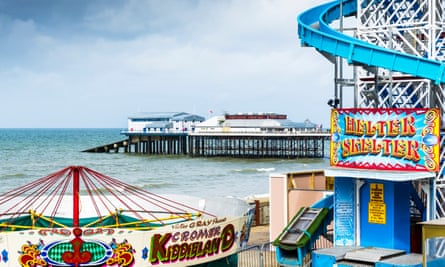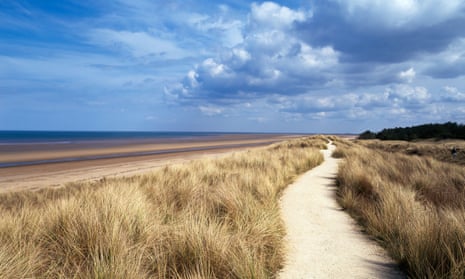One evening last summer, I took an overgrown track to the iron-age fort at Warham, two miles from the Norfolk coast. I stood on its great banks of flowery chalk grassland, alone, and watched the sun disappear, two barn owls and a tawny owl the only other living presences in the landscape.
It was a tranquil experience but also unexpectedly exhilarating. I felt I had slipped through conventional time; I didn’t come face-to-face with Boudicca exactly, but the past felt unusually present: mysterious, powerful, unsettling.
The north Norfolk coast is feted for its big skies and generous sandy beaches but this young coastline – still coming to terms with the last ice age – is also home to the most ancient of human traces. To the east, the rapidly eroding cliffs at Happisburgh recently revealed 850,000-year-old human footprints, the oldest yet found beyond Africa. To the west, erosion on the beach at Holme at the turn of the century uncovered Seahenge, a cryptic circle of oaks erected in the bronze age, possibly for funereal rites. These ancient marks, and the uncertainty around them, challenge and thrill us.

If you arrive on the Norfolk coast fresh from the bombastic cliffs of Dorset or the pounding Atlantic of Cornwall, then this land and its brown-grey North Sea (“Bronze, darling,” I was told by the artist Maggie Hambling) can appear underwhelming. There is rarely a grand collision of wave and rock in Norfolk; sea and land seep into each other via intricate, impenetrable grey-green salt marshes, and this landscape seeps into you, too, its space and subtle colours taking up residence.
I grew up half an hour inland and despite living so close we holidayed on the coast at Scolt Head Island and Holme Dunes nature reserve, two of a sextet of legendary nature reserves – Titchwell, Holkham, Blakeney Point and Cley are the others – where birders flock to watch avocet, terns and the unpredictable arrival of windblown rarities in winter. The north Norfolk coast is the cradle of British conservation: Blakeney Point was the first coastal nature reserve in Britain. Seal-watching is a popular excursion and witnessing great skeins of pink-footed geese honking as they descend on Holkham marshes at dusk in winter is one of the natural wonders of the world.

As a child, I loved the space and the freedom, roaming wild on dunes, exploring the second world war bunkers, messing about in the pine woods that make this coast a useful film double for New England in the US. As a young adult I was desperately homesick for its muted colours, the duns, olives and pewters, and the long summer evenings when the sun sets into the sea (sometimes, these days, into offshore wind farms) and the northern horizon stays light almost all night. I missed the winter too, when the wind tears at your face, the northern lights flash like secret signals and you can have three miles of beach to yourself. Actually, you can be alone here at any time of year.
Now that I’m living in Norfolk again, I still turn to its coast for recuperation, and not merely because a 45-minute journey is suddenly a key component of holiday happiness with three toddlers. In such a flat landscape, a little elevation goes a long way; climbing a sand dune gives you a mountaintop perspective. I’m still constantly surprised by the views across empty marshes and the sea; it is the wildest landscape left in southern Britain.

The Norfolk coast may be wild but there are plenty of home comforts, too. Holkham Hall is a fine example of a thriving stately home, and runs the acclaimed Victoria gastropub. To the east, the Gunton Arms is another excellent upmarket pub; inland, a superb newcomer is the Dial House in the pretty town of Reepham. The coastal villages of Cley and Blakeney and the little town of Burnham Market (“mark-up” say the locals) have been gentrified but, as with Cornwall, Norfolk retains a distinct local identity (despite Alan Partridge’s brilliant satire of generic provincialism): drily humoured, rebellious, sometimes suspicious, often eccentric. It is exemplified by Cookie’s crab shop at Salthouse, but it is found in many local pubs, too. My favourite is the Albatros, an atmospheric Dutch boat-pub moored at the quay on Wells-next-the-Sea.

London money is now being lavished on Cromer, a Victorian seaside resort with a splendid pier, old-fashioned amusements and several fine secondhand bookshops (particularly Much Binding on Church Street). Cromer is famed for its crabs but I get mine from the shack at Overstrand, a genteel village on the county’s highest cliffs.
Norfolk’s fresh air and subtle beauty would be enough but this coast also bequeaths us space, freedom, autonomy and community; four precious things that money cannot easily acquire. When these experiences combine, we can find ourselves momentarily liberated on that indeterminate line between land and sea.

Comments (…)
Sign in or create your Guardian account to join the discussion